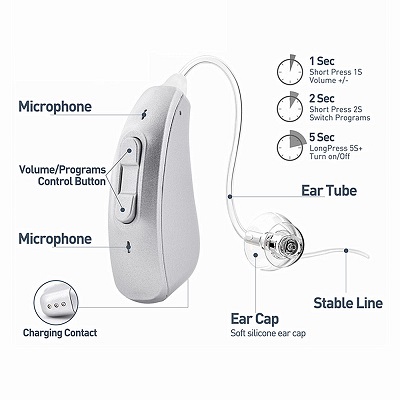The position of the hearing aid microphone can have an important effect on its performance.
In their study, Lybarger and Barron (1965) found that in BTE hearing aids, those with the microphone at the top performed better than those with the microphone at the bottom.
In addition, Berland and Nielson (1969) reported that among the three types of hearing aids, ITE, BTE and supra-aural, the gain was 7-10 dB higher in the 2000 and 5000 Hz frequency range compared to the other two types of hearing aids due to the advantage of the microphone position of the ITE hearing aid.
This is mainly due to the action of the pinna and the position of the ITE microphone in the ear. The microphone setup of the ITE has a superior localization ability compared to the BTE, whether worn in one or both ears, in quiet or in noisy environments (Orton and Preves, 1979).
Also, the former showed a 7% superiority in word recognition (Randolph et al., 1977). In addition, the high frequency response of microphones located at the top of the ITE was superior to that of microphones in other positions (Staab, 1980). Microphones located in the ear canal opening position (as in many CIC microphones) have about 5 dB higher gain at higher frequencies relative to ITC microphones (Garcia and Staab, 1995a, 1995b).
In environments with high airflow, turbulence around the hearing aid wearer’s head, around the hearing aid and at the microphone opening can cause wind noise. This noise around the head is difficult to eliminate completely.
Wind noise is highly dependent on wind speed, for example, it increases by more than 20 dB when the wind speed is doubled (Dalsgaard et al., 1967). Wind noise is closely related to the location and shape of the microphone opening.
Changing the airflow around the microphone or placing the microphone opening in a leeward position can effectively suppress wind noise. However, these methods only work on the part of the airflow through the microphone opening that causes wind noise.
Clothing noise is only associated with body-worn hearing aids. When hearing aids are concealed in clothing, the movement of the fibers covering the microphone opening causes clothing noise. Wearing the hearing aid on the outside of the clothing, setting the microphone on top of the hearing aid, and wearing soft, unstained clothing can reduce clothing noise (Libby, 1985).
Further Reading
RIC HEARING AIDS – “TREASURE” MODEL
SEVEN THINGS YOU HAVE TO KNOW ABOUT HEARING AIDS BEFORE YOU BUY THEM
EIGHT BENEFITS OF RECHARGEABLE HEARING AIDS
FREQUENTLY ASKED QUESTIONS ABOUT RIC-STYLE HEARING AIDS
WHY DOES MY HEARING AID CRACKLE?
Post time: Sep-29-2021

